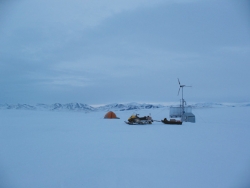CH2M HILL Polar Services (CPS), logistics provider to NSF's arctic research program, is busy supporting 2009 summer fieldwork. Projects on the CPS roster continue to be largely multi-institutional, international in scope, and focused on understanding the Arctic as a system. In addition to research support, CPS has several renewable energy projects planned for the 2009 summer; these projects continue work with NSF to reduce the impact of research on the fragile polar environment.
Approximately 135 research projects are currently slated to receive CPS services in the Arctic: 61 in Alaska, 56 in Greenland, 13 each in Canada and Russia, 3 in Iceland, 2 in Norway, and 9 in the Arctic Ocean and surrounding seas. These numbers are similar to those from 2008, with a small dip likely in the number of projects based in Greenland and on the Arctic Ocean and a significant bump—almost 40%—in the number of projects based in Russia. This year, NSF also increased CPS' responsibility for support to projects in Barrow, Alaska, where researchers on up to 40 NSF projects are expected to conduct fieldwork.
In early 2009, CPS supported a number of research teams working in remote Alaskan camps—a lake methane study led by University of Alaska's Katey Walter was a major early season effort. In March, CPS staff traveled to Shishmaref and Nome on Alaska's Seward Peninsula where they gathered assorted camp and project gear before traveling on snowmachines to Walter's research site at Cape Espenberg on the northern peninsula. The research team followed several days later. They worked for three weeks in the area, surveying and collecting methane samples from bubbles trapped in frozen thermokarst lakes and drilling lake sediment cores for study.

One of two solar and wind power systems currently at Imnavait Creek. As a pilot project this summer, CPS will install a methanol fuel cell at the adjacent site. The intent of the project is to improve data communications for both research sites by providing a more constant source of power while beta testing new technology in a field setting. Image by Tracy Dahl.
This NSF-funded project is international both in terms of its participants and its field locations. In addition to the Alaskan field work, a research team that includes Italian and German scientists will travel this summer to Chukotka, in far eastern Russia, to conduct similar studies based out of the Northeast Science Station at Cherskiy. Walters' research will compare results from Alaska and Russia to better understand the quantity of methane stored, the process by which it is released from these thermokarst lakes, and to predict the impact of the release as permafrost continues to thaw under a warming climate.
In addition to providing logistics support to a variety of research efforts, CPS has several experimental renewable/alternative energy projects planned this season. Around mid-June, CPS technicians will implement a cutting-edge alternative energy project at Imnavait Creek in northern Alaska. This site hosts a suite of monitoring instruments and experiments for the Arctic Long-Term Ecological Research (LTER) site at Toolik Field Station and a related Arctic Observing Network (AON) study of landscape-level carbon, water, and energy balance (see Witness Winter 2008/2009). The Imnavait Creek site needs a reliable year-round energy supply to power autonomous instruments, as well as a reliable communications link for massive data storage and transfer capabilities.
The new experimental system that CPS is deploying in mid-June adds a methanol fuel cell to an existing solar photovoltaic (PV) system. The fuel cell will power the communications link, which sends data once daily via broadband satellite to servers in California. In addition to overcoming the seasonal limitations of solar PV, fuel cell technology has potential for broader applications in polar research environments, as the power comes without electromagnetic noise and emissions that can interfere with some sensing instruments.
In addition to the new integrated power and communication system at Imnavait Creek, CPS engineers will also test lightweight, portable PV systems, being developed by project partners at Ascent Technologies, Inc., at the site. These systems could potentially be used by researchers who seek light yet rugged and quickly deployable power sources to run laptops and other devices in the field. A portable PV unit will receive trial use in Greenland and Alaska so CPS can evaluate its functionality under varied polar conditions.
At Summit Station on the Greenland ice cap, engineers will test solar thermal systems deployed on the exterior of a mobile science facility. The small building can be configured for a wide variety of research uses and towed to satellite research sites on skis. By utilizing the abundant solar energy available during the polar summer when this facility is in operation, CPS expects the thermal systems to reduce the electric heater power draw by up to 75%.
For more information, see the CPS website, or contact Kip Rithner (kip [at] polarfield.com).
